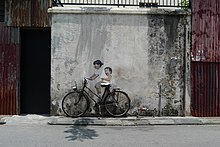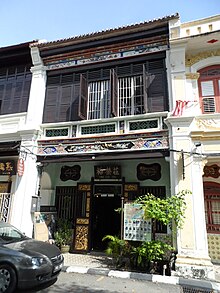5°24′53.08″N 100°20′17.2″E / 5.4147444°N 100.338111°E
 | |
| Native name |
|
|---|---|
| Maintained by | Penang Island City Council |
| Location | George Town |
| West end | Acheen Street |
| East end | Beach Street |
| Construction | |
| Inauguration | 1808 |
LEBUH ARMENIAN Armenian St10200 P. PINANG | |
| Type | Cultural |
| Criteria | ii, iii, iv |
| Designated | 2008 (32nd session) |
| Part of | George Town UNESCO Core Zone |
| Reference no. | 1223 |
| Region | Asia-Pacific |
Armenian Street is a narrow street in the city of George Town within the Malaysian state of Penang. Located within the city's UNESCO World Heritage Site, the road has gained popularity in recent years for its rich cultural offerings and street art.[1][2]
One of a number of places in the world that was named after the nation-state of Armenia, Armenian Street was originally part of a Malay settlement. The subsequent influx of Armenians and Chinese helped to shape the street's multicultural character. Notably, Armenian Street was also the site of Sun Yat-sen's Penang conference, which ultimately contributed to the downfall of the Qing Empire in 1911.

Today, Armenian Street is home to the famous 'Children on a Bicycle' mural by Ernest Zacharevic and various other forms of street art, as well as Chinese clan houses, museums, and shophouses that sell antiques and souvenirs.[3][4]


- ^ Yeoh, Winnie. "Couple tells story behind Zacharevic's famous mural on Armenian Street - Nation | The Star Online". Retrieved 2017-02-17.
- ^ "Penang island swamped by holiday crowds - Community | The Star Online". www.thestar.com.my. Retrieved 2017-02-17.
- ^ "Lebuh Armenian". Time Out Penang. Retrieved 2017-02-17.
- ^ Eckhardt, Robyn (2012-02-09). "36 Hours: Penang, Malaysia". The New York Times. ISSN 0362-4331. Retrieved 2017-02-17.